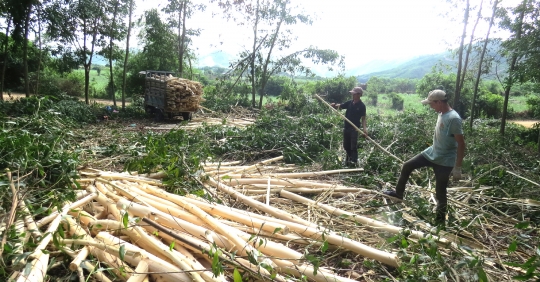In recent years, many agricultural areas in Phu Yen, farmers have massively abandoned planting cassava and sugarcane to follow acacia. Planted acacia soil discolors according to the recommendations of the functional sector, the roots are deeply rooted, later it is very difficult to improve and plant other species of trees. Currently, the price of acacia wood has fallen, making it difficult for farmers while cassava factories are running out of raw materials.
Consequences of growing acacia on agricultural land
Along National Road 19C, which passes Xuan Lanh, Xuan Long and Dong Xuan District (Phu Yen), acacia trees appear green on both sides of the road. Formerly planted with cassava, sugar cane and beans, this area of land is now overgrown with acacia trees.
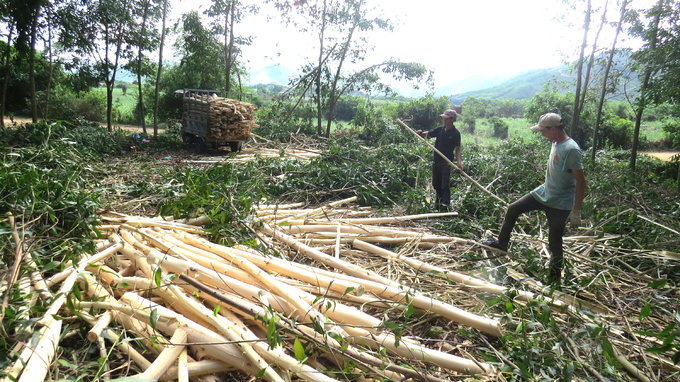
Farmers in Da Loc township in Dong Xuan district harvest acacia trees. Picture: Manh Hoai Nam.
Mr Tran Van Dung, farmer in Xuan Long Township said: The land area from Tra O Bridge (Xuan Lanh Township) down to Loch Cay Anti (Xuan Long Township) used to be sugar cane, which was then converted to cassava for acacia plantation. Not only in this area, but from Xuan Lanh Township to Da Loc Township, there are no cassava and sugar cane trees, but acacia forests. There are places where acacia trees are planted by the roadside next to the ditch.
The situation of acacia cultivation on agricultural land is still ongoing in Xuan Quang 3 Township, Xuan Phuoc (Dong Xuan District). Ms. Phan Thi Huong from Xuan Quang Township 3 said: 3 years ago, the whole township could not find sugar cane, the whole hilly area also planted a few cassava clusters, but cassava ended up suffering from curly leaf mosaic disease At harvest there were no tubers, farmers switched to growing acacia.
“My house has a hill of land that grows cassava, but people on both sides grow acacia, so I force myself to follow the acacia tree. Three months ago, the price of raw wood was VND 1.7 million/ton, recently the price of acacia fell to only VND 1.2 million/ton, and traders announced that they would soon stop buying, and acacia growers distorted theirs faces. said Huong.
In Son Hoa District (Phu Yen), the cultivation of acacia on agricultural land is widespread in Son Dinh, Son Hoi and Ca Lui communes. Mr. So Y Rin, Ca Lui Municipality-Construction Officer, said: The land area for annual crops converted to acacia tends to increase, affecting households using adjacent land and violating the regulations of the land use plan.
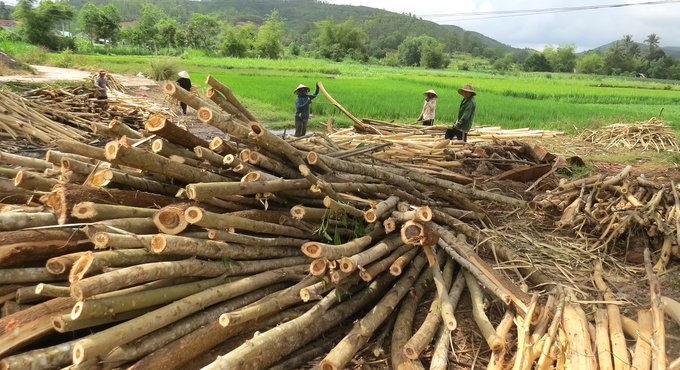
Acacia gardens are planted right next to the rice fields. Picture: Manh Hoai Nam.
The acacia tree encroached on the land because the person with the adjacent land planted acacia, the person with the adjacent land also had to dig holes to plant them because the large acacia stuck the cassava and could not grow. When the price of glue goes down, not only do few people suffer, but many have trouble following it. Meanwhile, farmers now want to destroy the roots of acacia to plant cassava and sugar cane again, the cost is very high (up to millions / Sao), because they have to plow and break the deep-rooted roots, must be a big plow, plow many just. Simply pulled out the glue root.
break the plan
Because the price of raw wood has always been stable at a high level in recent years, while cassava and sugar cane are not stable from price to production, people have flocked to plant acacia on agricultural land, according to local authorities. . The immediate consequence to be borne by the agricultural sector is that the voluntary conversion of arable land to forestry by the population will influence the province’s agricultural development planning.
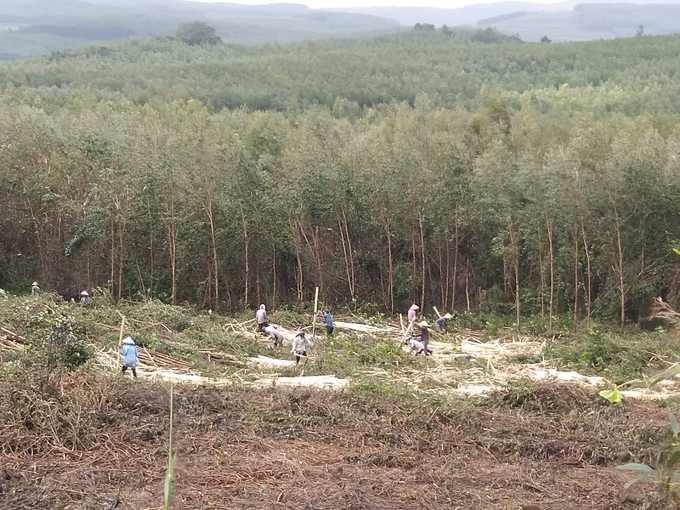
The acacia tree only brings in income of about 10 million VND/ha/year, while cassava cultivation also brings in income of 30 million VND/ha/year. Picture: Manh Hoai Nam.
According to the agribusiness, the farmers who suffer the damage directly are those who voluntarily plant acacia trees on agricultural land. Currently, the price of raw wood is VND 1.2 million/ton, with an average yield of 60 to 70 tons/ha, farmers can earn profit of VND 50 million/ha after a 5-year planting cycle. Divided, 1 ha of acacia only yields more than 10 million dong income every year, that is not deducting the investment cost during the cycle and the exploitation cost. If this land area is planted with cassava, only one crop can get VND 30 million at best. Not to mention that if China stops buying wood chips, people’s acacia trees will just die.
In the past, farmers have followed the economic reforestation movement and threatened to disrupt the cassava and sugarcane planning area, which provides processing materials for factories in the region. Therefore, the Ministry of Agriculture and Rural Development of Phu Yen has advised people not to abide by the price, but to plant apricot trees strictly according to the plan approved by the provincial People’s Committee.
This year’s cassava area planted by farmers is 20,972 hectares, down nearly 5,000 hectares from the previous crop year, according to statistics from the Phu Yen Provincial Subdivision of Crop Protection and Cultivation. Most worryingly, farmers in the cassava planning area have switched to economic afforestation, which risks disrupting the planning.
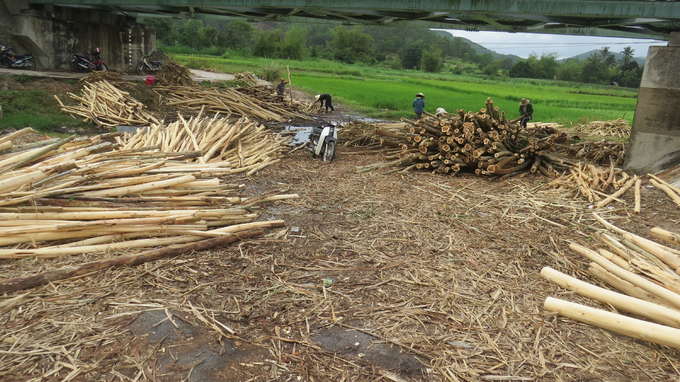
The conversion of agricultural land to forestry means that farmers are the first to bear the loss. Picture: Manh Hoai Nam.
Mr Nguyen Van Minh, director of Phu Yen’s Cultivation and Plant Protection Sub-department said: When the acacia grows, the canopy will block the sunlight, the trees below will be hidden from the sun. Acacia leaves contain oil. If they fall to the ground, the plants underneath die cleanly.
Acacia roots absorb all the nutrients in the soil in the process of development, making the soil infertile, later it is very difficult to grow other plants. Also, because farmers switched countries to plant cassava and sugarcane to plant acacia, this year two cassava starch processing factories in the province had to mass produce or stop production earlier than planned due to shortage of raw materials.

